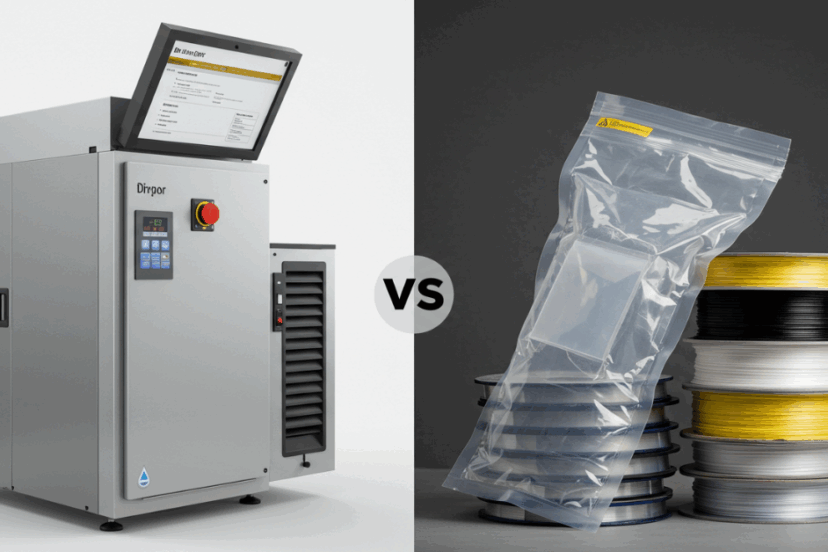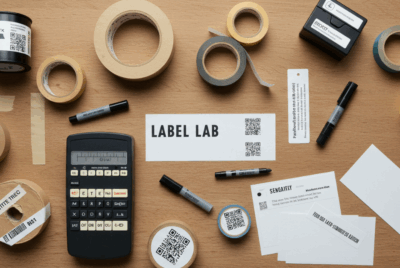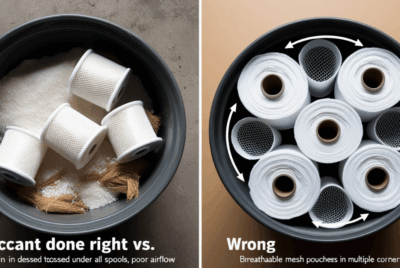Vacuum Sealing vs. Dry Boxes: What’s Best for Storing 3D Filament?
1. Two Champions of Filament Storage
If you’re tired of wasting money on soggy filament and failed prints, you’ve probably come across two major storage methods: vacuum sealing and dry boxes.
But which one is actually better?
Let’s break it down and help you make the best choice for your filament, your space, and your printing style.
2. Why Filament Needs Extra Protection
Filament isn’t just plastic—it’s moisture-sensitive plastic. If it absorbs too much humidity, you’re looking at:
- Popping and bubbling while printing
- Stringy messes
- Brittle or warped prints
- Nozzle clogs
That’s why smart storage isn’t optional—it’s essential.
3. What is Vacuum Sealing for Filament?
Vacuum sealing involves placing your filament spool in an airtight bag and removing all the air—often with a hand or electric pump. Then you toss in a silica gel packet and seal it shut.
Perfect for:
- Long-term storage
- Backup spools
- Travel or off-site storage
4. What is a Filament Dry Box?
A dry box is a sealed container designed to keep filament at a low relative humidity. Many are actively heated and allow you to print directly from the box while maintaining a dry environment.
Perfect for:
- Everyday printing
- Humid environments
- Multiple spool setups
5. Head-to-Head: Key Differences
| Feature | Vacuum Sealing | Dry Box |
|---|---|---|
| Cost | Lower upfront cost | Higher upfront cost |
| Ease of Use | Basic (manual sealing) | Plug-and-play with features |
| Print-While-Storing | ❌ No | ✅ Yes |
| Space-Saving | ✅ Compact | ⚠️ Bulkier |
| Ideal for | Long-term storage | Daily use or humid areas |
6. Vacuum Sealing Pros & Cons
✅ Pros:
- Very affordable
- Great for archiving filament
- Compact, stackable storage
- Keeps air and humidity out
❌ Cons:
- Not convenient for daily use
- Needs to be resealed every time you open it
- Can deform soft filament if over-sealed
7. Dry Box Pros & Cons
✅ Pros:
- Active humidity control
- Print directly from the box
- Often has built-in spool holders and sensors
- Great for multi-day or large prints
❌ Cons:
- Higher initial cost
- Takes up more space
- Some models need power to maintain RH
8. Which One Is Better for Humid Climates?
💡 Winner: Dry Box
In places where the humidity is always high—think coastal cities or tropical areas—a dry box gives you real-time humidity control. Some models even actively dry your filament while stored.
9. Which Works Best for Everyday Printing?
💡 Winner: Dry Box
Dry boxes let you load, store, and print without hassle. No resealing, no juggling bags. If you print every week (or every day), they’re a huge time-saver.
10. Can You Use Both Together?
Absolutely—and it’s a power move.
Here’s a smart setup:
- Keep actively-used spools in a dry box
- Keep backup spools vacuum-sealed
- Rotate between them as needed
This way, you’re optimizing both long-term storage and daily use.
11. Filament Types That Need Extra Storage Love
| Filament | Vacuum Sealing | Dry Box | Both |
|---|---|---|---|
| PLA | ✅ Yes | ✅ Yes | ✅ |
| ABS | ✅ Yes | ✅ Yes | ✅ |
| Nylon | ⚠️ Better with drying | ✅ Strongly recommended | ✅ |
| TPU | ✅ Yes | ✅ Yes | ✅ |
| PVA | ❌ Use dry box only | ✅ Must use | ✅ |
Some filaments, like PVA or Nylon, are so moisture-sensitive that a dry box is almost non-negotiable.
12. How to Choose Based on Your Workflow
Choose Vacuum Sealing if you:
- Store filament for long periods
- Have limited storage space
- Don’t print frequently
Choose Dry Box if you:
- Print regularly or professionally
- Use moisture-sensitive materials
- Live in a humid area
- Want plug-and-play ease
13. Real-World Product Examples to Try
🔹 Top Dry Boxes:
- SUNLU Filament Dryer Box S2 – budget-friendly with digital display
- PrintDry Pro – handles multiple spools, great for Nylon
- Polymaker PolyDryer – reliable and sleek design
🔹 Top Vacuum Seal Kits:
- Fisch Vacuum Storage Bags – reusable and strong
- Geryon Vacuum Sealer Kit – great for filament and food
- eSun Vacuum Bags + Hand Pump – designed for 3D printing spools
14. DIY Options for Both Systems
DIY Vacuum Sealing:
- Use Ziploc-style vacuum bags with a manual pump
- Add silica gel packs
- Label with type/date for easy access
DIY Dry Box:
- Use an airtight plastic container
- Add a spool holder rod, hygrometer, and desiccant packs
- Feed filament through a rubber grommet hole to your printer
15. Final Thoughts: Which Storage Method Wins?
There’s no one-size-fits-all answer—it depends on your space, habits, and climate.
- If you’re a weekend maker, vacuum sealing may be all you need.
- If you’re printing every day or with exotic filaments, a dry box is worth every penny.
- If you want the ultimate setup, use both!
Bottom line: the best method is the one that keeps your filament dry, accessible, and frustration-free.
❓FAQs
- Can I vacuum seal filament that’s already opened?
Yes! Just make sure it’s dry before sealing, and toss in a silica gel packet. - Can I store multiple spools in one dry box?
Depends on the model. PrintDry Pro can store multiple, while smaller units like SUNLU S2 hold one. - Do dry boxes really make a difference in print quality?
Yes. Especially with moisture-sensitive filaments like Nylon and PETG. - How long does vacuum-sealed filament last?
Up to 2 years or more if properly sealed and kept away from heat/light. - Should I dry filament before vacuum sealing it?
Absolutely. Sealing moist filament just traps the problem inside.




